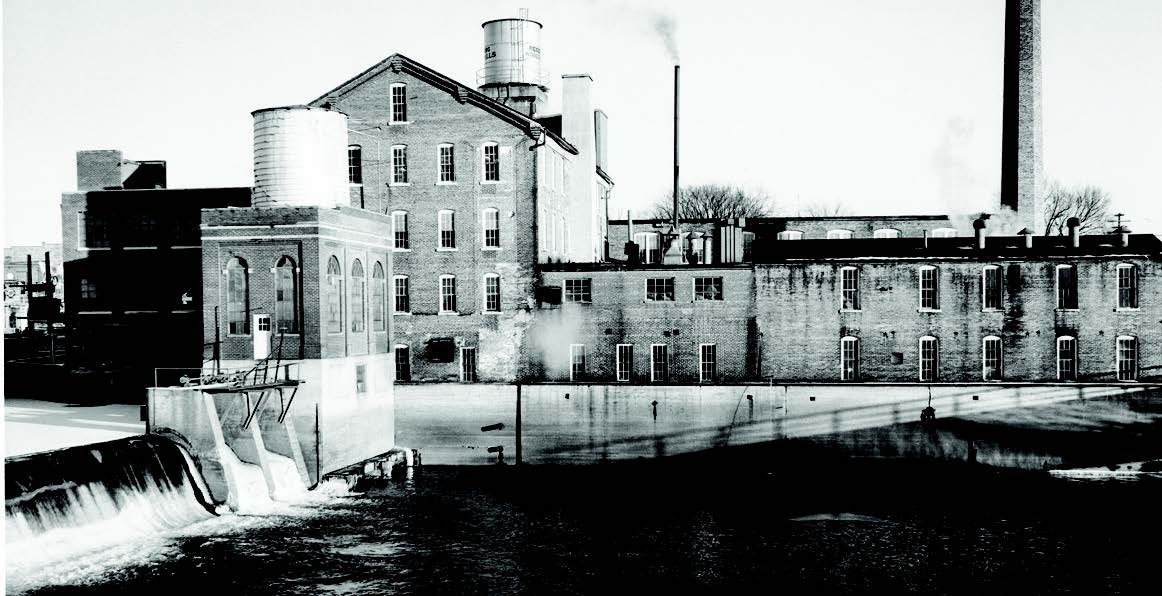The Reedsburg Mill and Dam Removal
By Jeff Seering
“It’s nothing but a weed patch!” That’s the way my Dad described the old Reedsburg mill pond area in the years after the Woolen Mill dam was removed. He wasn’t far from the truth. While the Baraboo River became semi-famous for numerous dam removals around the year 2000, the Reedsburg dam was removed in 1973 by the Wisconsin Department of Natural Resources.
The millpond had been part of Reedsburg’s community character right up until the dam’s removal in 1973. The Reedsburg Woolen Mill was one of the city’s largest employers and industries up until the time it closed in 1967 after the business went bankrupt. The four story building towered over the west end of the downtown right up until burned in 1968. While the old Woolen Mill office still stands and is now a storefront, the factory portion was destroyed. The only remaining part of it is the concrete retaining wall along the east side of the river south of the Main Street bridge.
With the business bankrupt, ownership of the dam eventually fell to Sauk County. The dam no longer served a useful purpose with the mill gone and the DNR removed it in 1973. All expense was spared as far as rehabilitating the area where the mill pond once stood. The dam was taken out and that was it. Nothing was done to enhance the drained millpond area, at least not immediately. A large mud flat was exposed, except for where the river reestablished its channel.
The old mill pond wasn’t very deep after silting in for more than a century. But it has a certain charm with a couple of islands in it just north of the Main Street bridge as well as numerous other islands farther upstream in the Webb Park area.
Reedsburg Woolen Mill loom
In the 1940s a local boat club was using the river and historical reports say there was a park of sorts, called Sherwood in the area by the radio station on the west end of town, which was river destination. But by the 1960s there wasn’t a lot of boat traffic anymore. The millpond backed up Hay Creek all the way to the County V bridge, just west of Webb Field. Occasionally foul balls from the baseball diamond went in the drink.
Brewery Point, the area west of the Webb swimming pool was a popular fishing spot as was the County V bridge, where a fisherman or two could be seen just about every week. But the pond was shallow for the most part, which meant no one motored on the river much anymore. Our family lived about a quarter mile west of the County V bridge. A few times each summer, my brother, I, and maybe some friends would load our Dad’s eight foot wooden pram on my red wagon and roll it down to the bridge and put it in.
We’d row it on the millpond, exploring the islands, sometimes landing on the island across from Webb Park and taunting the land lubbers in the park. The islands formed a labyrinth to explore, though the channels between them were shallow and full of carp, which we sometimes speared in the spring. We never saw another boat.
The millpond was always a muddy brown, In the winter we would ice skate in the area of pond closest to our home. The things you most associated with the Baraboo river in the 60s were mud and carp. But the pond did present a scenic view north from the Main Street bridge, which the DNR just left to go to seed and weeds when the dam was torn out.
But there were some visionaries in the community. Roger Popple, a Webb High science teacher, and some of his students, saw potential in the old mill pond area. Popple was an environmental education pioneer, teaching Conservation classes that emphasized forestry, wildlife management and water quality monitoring.
He and his students designed and built a nature trail system that connected the downtown area to Webb Park. While nature has changed some of the original trails through the years, the Roger Popple Nature Area trail system is still going strong today. If you walk it, you can still see where the pond was, now wetalnds, and the island areas, which have the trees. More recently the Disconsin team has installed a disc golf course in that area. Between hikers, dog walkers and disc golfers, the area receives far more public use than it ever did when it was a mill pond.
In 1976 a local group installed a Bicentennial Monument on the former island just north of the Main Street bridge to commemorate the 200th birthday of the United States, complete with a time capsule to be opened in 2076. It took time and nature a while for the old millpond area to assume a new character, use and appreciation.
Reedsburg’s experience with the removal of its dam had an effect on plans for the removal of the LaValle Mill dam in 1999. The Sand County Foundation, which purchased the old mill with the intention of removing the dam, agreed to a plan to install a new pond, separate from the river in that community, keeping in place a reflective view of the Bodendein farm that once graced the cover a national dairy magazine. So LaValle kept the majority of its pond, because more careful planning and community input took place than had happened in Reedsburg over 25 years earlier.


